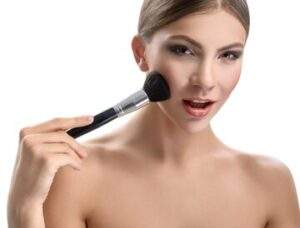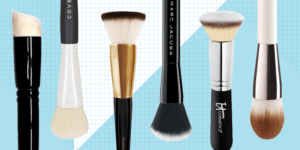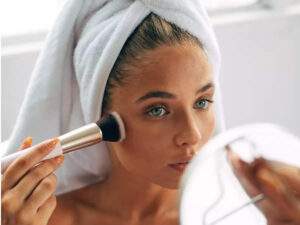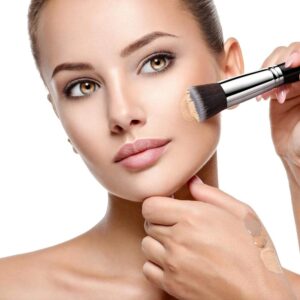Choosing the Best Foundation Brush for Flawless Skin: A Complete Guide
Achieving flawless skin starts with the right foundation, but even the best foundation can look uneven if applied incorrectly. The key to achieving a perfect finish lies in using the appropriate foundation brush. With so many options available, selecting the best one can be daunting. But fret not, we’ve got you covered! Our comprehensive guide covers everything you need to know about selecting the ideal foundation brush for immaculate skin. We’ll delve into the various types of brushes, the materials used, and how to use them to guarantee optimal results. Say goodbye to streaky foundation and say hello to a flawless complexion!

1. Introduction to foundation brushes
When it comes to applying foundation, the tool you use can make all the difference. While some people may prefer using their fingers or a sponge, using a foundation brush is a popular choice for achieving a flawless finish.
Foundation brushes come in a variety of shapes, sizes, and materials, and each one has its unique benefits. Some brushes are designed for full coverage, while others are better suited for light or medium coverage. Some brushes are angled for precision, while others have a flat top for more even application.
Using a foundation brush can also help you to use less product while still achieving the desired coverage. This can save you money in the long run by making your foundation last longer.
In this guide, we’ll take a closer look at the different types of foundation brushes available and help you determine which one is the best choice for your skin type and desired coverage level. So, whether you’re a makeup novice or a seasoned pro, read on to learn everything you need to know about choosing the best foundation brush for flawless skin.

2. Types of foundation brushes and their uses
When it comes to applying foundation, using the right brush can make all the difference in achieving a flawless finish. There are several types of foundation brushes available in the market, each with its unique shape and size designed for different purposes.
Firstly, let’s talk about the most commonly used foundation brush – the flat brush. This type of brush is perfect for applying liquid foundation as it helps to evenly distribute the product on the skin surface. Its flat shape also allows for easy blending, making it suitable for creating an airbrushed finish.
Next up, we have the stippling brush. This brush is made up of two types of bristles – long and short. The long bristles help to deposit the product on the skin, while the short ones blend it in seamlessly. Stippling brushes are ideal for applying cream or powder foundations as they offer a lighter coverage compared to flat brushes.
Another type of brush that has been gaining popularity recently is the buffing brush. This brush has densely packed bristles that are tightly packed together, making it perfect for buffing in liquid or cream foundation. The buffing brush also helps to blend in the foundation effectively, creating a natural-looking finish.
Lastly, we have the angled foundation brush, which is ideal for applying foundation to hard-to-reach areas such as around the nose and eyes. Its angled shape also makes it suitable for contouring and highlighting, giving your face a defined look.
In conclusion, choosing the right foundation brush depends on your personal preference, the type of foundation you’re using, and the coverage you want to achieve. Experiment with different brushes to find the one that works best for you and your skin type.
3. The difference between synthetic and natural bristles
When it comes to choosing a foundation brush, one of the most important factors to consider is the type of bristles. The two main types of bristles are synthetic and natural. Synthetic bristles are made from man-made fibers, while natural bristles come from animal hair, such as goat or horse hair.
One of the biggest benefits of synthetic brushes is that they are cruelty-free and vegan, making them a great choice for those who prefer to use animal-free products. They are also less prone to shedding and are often more durable than natural brushes. Synthetic brushes are also great for use with liquid or cream foundations, as they tend to provide a smooth and even application.
On the other hand, natural bristle brushes are known for their softness and ability to pick up and distribute powder products, such as mineral foundation or setting powder, with ease. They also tend to be more porous than synthetic brushes, which allows them to pick up more product and provide a more natural finish.
Ultimately, the choice between synthetic and natural brushes comes down to personal preference and the type of foundation you are using. If you prefer a vegan and cruelty-free option, or if you are using a liquid or cream foundation, a synthetic brush may be your best bet. However, if you are using a powder foundation or prefer a softer touch, a natural bristle brush may be the way to go.

4. How to choose the right foundation brush for your skin type
Choosing the right foundation brush for your skin type is crucial in achieving a flawless finish. Different skin types require different brush bristles to ensure that the foundation is applied evenly and blends well. Here are some tips on how to choose the right foundation brush for your skin type:
1. For oily skin: If you have oily skin, you want to choose a brush with synthetic bristles. Synthetic bristles are great for applying liquid foundation because they don’t absorb the product, which means you can use less foundation and get more coverage.
2. For dry skin: If you have dry skin, you want to choose a brush with soft, fluffy bristles. A brush with densely packed bristles can irritate dry skin and make it look even more flaky. Soft, fluffy bristles will help to blend the foundation seamlessly into the skin, without emphasizing any dry patches.
3. For combination skin: If you have combination skin, you want to choose a brush with a mix of synthetic and natural bristles. This will allow you to apply foundation to the oily areas of your face without caking it on, while still being gentle enough to blend onto the dry areas.
4. For sensitive skin: If you have sensitive skin, you want to choose a brush with synthetic bristles that are soft and gentle on the skin. Avoid brushes with rough bristles that can cause irritation or redness.
In summary, choosing the right foundation brush for your skin type is key to achieving the perfect finish. By following these tips, you’ll be able to find the perfect brush that will help you achieve a flawless complexion every time.
5. The best foundation brushes on the market
When it comes to achieving flawless skin, using the right foundation brush can make all the difference. There are a plethora of foundation brushes on the market, each with their own unique shape, bristle type, and density. So, how do you know which one to choose?
Firstly, it’s important to consider the type of foundation you’ll be using. For liquid foundations, a flat or rounded brush with synthetic bristles works best. These types of brushes are great for blending and offer a smooth, airbrushed finish. For cream foundations, a dense, flat brush with natural bristles will provide better coverage and help to create a flawless finish.
Another factor to consider when choosing a foundation brush is the shape. Angled brushes are great for applying foundation to hard-to-reach areas like the corners of the nose or the under-eye area. Round brushes are ideal for applying foundation to larger areas like the cheeks and forehead, while flat brushes work well for blending and layering.
Of course, the quality of the brush is also important. Investing in a high-quality foundation brush may cost more upfront, but it will last longer and provide better results.
Ultimately, choosing the best foundation brush for your needs will depend on your personal preference and the type of foundation you use. By considering factors like bristle type, shape, and quality, you can find the perfect brush to help you achieve a flawless, airbrushed finish.
6. How to clean and care for your foundation brush
Once you have found the perfect foundation brush, it’s important to take care of it to ensure that it lasts a long time and maintains its quality. Here are some tips on how to clean and care for your foundation brush:
1. Clean your brush regularly: It’s important to clean your foundation brush after each use to avoid the buildup of bacteria and oil. Use a gentle cleanser or shampoo and lukewarm water to clean the brush thoroughly. Be sure to rinse it well and gently squeeze out any excess water.
2. Dry your brush properly: After cleaning, reshape the brush and lay it flat on a towel to dry. Avoid standing the brush upright as this can cause water to seep into the handle and loosen the bristles.
3. Store your brush correctly: Store your foundation brush in a brush holder or a clean, dry place. Avoid storing it in a closed container as this can cause the bristles to bend and lose their shape.
4. Avoid harsh chemicals: Avoid using harsh chemicals or alcohol-based cleaners to clean your foundation brush as these can damage the bristles and cause them to shed.
By following these simple steps, you can keep your foundation brush in top condition and ensure that you get the best performance from it every time you use it. Remember, a clean brush will not only help you achieve flawless skin, but it will also prevent skin irritation and breakouts.
7. Alternatives to foundation brushes
While foundation brushes are a great tool for achieving flawless skin, they may not be the best option for everyone. Luckily, there are a number of alternatives to foundation brushes that can provide equally impressive results.
One popular alternative is a makeup sponge. Sponges can be used to apply foundation, concealer, and even powder. They are great for achieving an airbrushed finish and can be used wet or dry depending on the desired level of coverage.
Another option is a stippling brush. These brushes are typically made with two different types of bristles, which allows for a more natural-looking finish. Stippling brushes are great for lightweight foundations, as they do not pick up too much product at once.
For those who prefer a hands-on approach, using your fingers to apply foundation is also a great option. This method can provide a more natural finish and allows you to control the level of coverage more easily. However, it is important to make sure your hands are clean before starting.
Ultimately, the best alternative to a foundation brush will depend on your personal preferences and skin type. It may take some trial and error to find the perfect tool, but with a little experimentation, you can achieve the flawless, airbrushed look you desire.

8. Tips for achieving flawless skin with a foundation brush
Using a foundation brush is a great way to achieve a flawless, even complexion. Here are some tips to help you get the best results:
1. Start with a clean canvas: Always start with a freshly washed and moisturized face. This will help your foundation go on smoothly and evenly.
2. Choose the right foundation: Your foundation should be a good match for your skin tone and type. It’s important to choose a formula that works for your skin type, whether you have oily, dry, or combination skin.
3. Use the right brush: There are many different types of foundation brushes available, from flat brushes to angled brushes to stippling brushes. Choose the brush that works best for your skin type and the type of foundation you’re using.
4. Apply in thin layers: Start with a small amount of foundation and apply it in thin layers, using your brush to blend it out evenly. This will help you build up coverage without looking cakey.
5. Don’t forget to blend: Make sure to blend your foundation down your neck and onto your chest to avoid any harsh lines or color mismatches.
6. Set with powder: To help your foundation last all day, set it with a translucent powder. This will also help to mattify any shine and keep your skin looking flawless.
By following these tips, you’ll be able to achieve a flawless, airbrushed look with your foundation brush. Practice makes perfect, so don’t be afraid to experiment until you find the technique that works best for you.
9. Common mistakes to avoid when using a foundation brush
While using a foundation brush may seem straightforward, there are some common mistakes that people make that can affect the final look of their makeup. Here are a few to avoid:
1. Not cleaning your brush regularly: Dirty brushes can lead to clogged pores and breakouts. Make sure to clean your brush after each use or at least once a week if you use it daily.
2. Using too much foundation: A little goes a long way with foundation, and using too much can lead to a cakey, unnatural look. Start with a small amount and build up coverage as needed.
3. Using the wrong brush for your foundation: Different types of foundation require different types of brushes. For example, a dense, flat brush is best for liquid foundation, while a fluffy, angled brush is better for powder foundation.
4. Using the wrong technique: Using a circular or buffing motion can create streaks and uneven coverage. Instead, use a patting or stippling motion to blend the foundation seamlessly into your skin.
5. Not blending properly: Skipping the blending step can leave harsh lines and uneven coverage. Take the time to blend your foundation thoroughly, especially around the jawline and hairline.
By avoiding these common mistakes, you can ensure that your foundation brush is working for you, and not against you, in achieving flawless-looking skin.
10. Conclusion and final thoughts
In conclusion, choosing the best foundation brush can be a daunting task, but it doesn’t have to be. With the right knowledge and understanding of your skin type and coverage needs, you can make an informed decision that will help you achieve the flawless look you desire.
Remember to consider the bristle type, shape, and size of the brush, as well as your budget and personal preferences. Investing in a high-quality foundation brush can make a huge difference in the application and finish of your makeup, so it’s worth it to do your research and find the perfect brush for you.
Lastly, always remember to clean your brushes regularly to maintain their quality and prevent bacteria buildup. With the right brush and proper maintenance, you can achieve a flawless foundation application every time. We hope this guide has been helpful in your quest for the perfect foundation brush and wish you all the best in your beauty endeavors.
We hope that this complete guide on choosing the best foundation brush for flawless skin has helped you in making an informed decision. As we have discussed, using the right foundation brush can make a significant difference in the appearance of your skin. With so many options available in the market, it can be challenging to choose the perfect one. But, by considering the factors we have highlighted and following the tips we have provided, you are sure to find the right foundation brush that works best for your skin type and desired finish. Now, go ahead and achieve that flawless base you’ve always wanted!
If you’re looking for a new foundation brush, you don’t have to spend a ton of money. Click Here to get a Killer Foundation Brush Now!
Related Articles:
Mastering the Art of Foundation: A Guide to Using a Foundation Brush
Choosing the Best Foundation Brush for Flawless Skin: A Complete Guide
From Kabuki to Stippling: How to Choose the Perfect Foundation Brush for Flawless Makeup Application
Flawless Application: Mastering Foundation Brush Techniques
Foundation Brush Maintenance: Tips and Tricks For Regular Cleaning
Or, if you would feel more comfortable buying our products from one of the major marketplaces, please feel free to select from the links below: